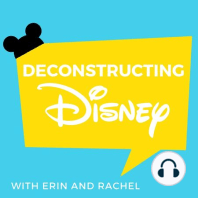99 min listen
Peter Pan
ratings:
Length:
117 minutes
Released:
Sep 8, 2020
Format:
Podcast episode
Description
Episode SummaryErin and Rachel have A LOT of thoughts (just under two hours worth) about Peter Pan (1953), a film so full of racism and sexism, they’re left scratching their heads about why this Disney classic is so beloved. Join the hosts as they unpack all the different ways this movie is offensive toward indigenous people, women, and even people with disabilities! Episode BibliographyBoyd, J. (2015). An examination of Native Americans in film and rise of Native filmmakers. The Elon Journal of Undergraduate Research in Communications, 6(1), 105-113. https://www.elon.edu/docs/e-web/academics/communications/research/vol6no1/10BoydEJSpring15.pdfGeronimi, C., Jackson, W., & Luske, H. (Directors). (1953). Peter Pan [Film]. Walt Disney Animation Studios.Great Ormond Street Hospital. (n.d.). The history of Peter Pan and GOSH. https://www.gosh.org/about-us/peter-pan/historyGrady, C. (2017, July 27). How the fantasy of Peter Pan turned sinister. Vox. https://www.vox.com/culture/2017/7/27/16021572/peter-pan-became-evil-jm-barrie-llewelyn-daviesHooten, C. (2015, August 27). Please stop calling it the Bechdel Test, says Alison Bechdel. Independent. https://www.independent.co.uk/arts-entertainment/films/news/please-stop-calling-it-the-bechdel-test-says-alison-bechdel-10474730.htmlJoo-Young, Rognlie. (2012, November 6). Copyrights in Neverland. Harvard Journal of Sports and Entertainment Law. Retrieved from https://harvardjsel.com/2012/11/copyrights-in-neverland/Kavey, A. B. (2008). “I do believe in fairies, I do, I do”: The history and epistemology of Peter Pan. In A. B. Kavey & L. D. Friedman, (Eds.), Second star to the right: Peter Pan in the popular imagination (pp. 75-104). Rutgers University Press. Lane, A. (2004, November 15). Why J. M. Barrie created Peter Pan. The New Yorker. https://www.newyorker.com/magazine/2004/11/22/lost-boysLaskow, S. (2014, December 2). The Racist History of Peter Pan’s Indian Tribe. Smithsonian Magazine. https://www.smithsonianmag.com/arts-culture/racist-history-peter-pan-indian-tribe-180953500/Mohamed, Z. (2019, December 15). Indigenous representation in media. https://storymaps.arcgis.com/stories/34bdcbb62ba04aa2a63a2bdc1e8accabMoss, C. (2014, December 4). The surprisingly morbid origins of Peter Pan. The Week. https://theweek.com/articles/441765/surprisingly-morbid-origins-peter-pan#:~:text=Peter%20Pan%20originally%20debuted%20as,Who%20Wouldn't%20Grow%20Up.National Congress of American Indians. (2017). Misappropriation of Native Identity in Film & Television. http://www.ncai.org/resources/resolutions/misappropriation-of-native-identity-in-film-televisionOhmer, S. (2008). Disney’s Peter Pan: Gender, fantasy, and industrial production. In A. B. Kavey & L. D. Friedman, (Eds.), Second star to the right: Peter Pan in the popular imagination (pp. 151-186). Rutgers University Press. Parasher, P. (2013). Mapping the imaginary: The Neverland of Disney Indians. In J. Cheu (Ed.), Diversity in Disney films: Critical essays on race, ethnicity, gender, sexuality and disability (pp. 38-49). McFarland & Company, Inc. Peter Pan (1953 Film). (2020, August 5). In Wikipedia. Retrieved from https://web.archive.org/web/20200804192746/https://en.wikipedia.org/wiki/Peter_Pan_(1953_film)
Released:
Sep 8, 2020
Format:
Podcast episode
Titles in the series (50)
Fantasia: Erin and Rachel review Disney’s Fantasia (1940) segment by segment and discuss the film’s repeated racist, female objectifying, and fatphobic imagery. But the music and unicorns are pretty! Maybe there’s a reason Disney likes to focus on Sorcerer Mickey when they talk about this film... by Deconstructing Disney
